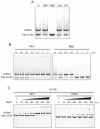Structural and Functional Characterization of the Holliday Junction Resolvase RuvC from Deinococcus radiodurans
- PMID: 35744678
- PMCID: PMC9228767
- DOI: 10.3390/microorganisms10061160
Structural and Functional Characterization of the Holliday Junction Resolvase RuvC from Deinococcus radiodurans
Abstract
Holliday junctions (HJs) are four-way DNA structures, which are an important intermediate in the process of homologous recombination. In most bacteria, HJs are cleaved by specific nucleases called RuvC resolvases at the end of homologous recombination. Deinococcus radiodurans is an extraordinary radiation-resistant bacterium and is known as an ideal model organism for elucidating DNA repair processes. Here, we described the biochemical properties and the crystal structure of RuvC from D. radiodurans (DrRuvC). DrRuvC exhibited an RNase H fold that belonged to the retroviral integrase family. Among many DNA substrates, DrRuvC specifically bound to HJ DNA and cleaved it. In particular, Mn2+ was the preferred bivalent metal co-factor for HJ cleavage, whereas high concentrations of Mg2+ inhibited the binding of DrRuvC to HJ. In addition, DrRuvC was crystallized and the crystals diffracted to 1.6 Å. The crystal structure of DrRuvC revealed essential amino acid sites for cleavage and binding activities, indicating that DrRuvC was a typical resolvase with a characteristic choice for metal co-factor.
Keywords: Deinococcus radiodurans; Holliday junction; Mn2+; RuvC.
Conflict of interest statement
The authors declare no conflict of interest.
Figures





References
Grants and funding
LinkOut - more resources
Full Text Sources

